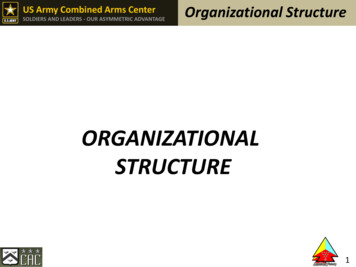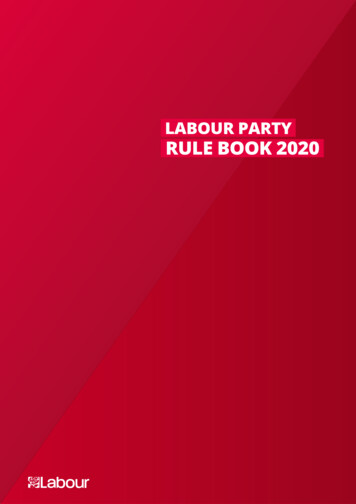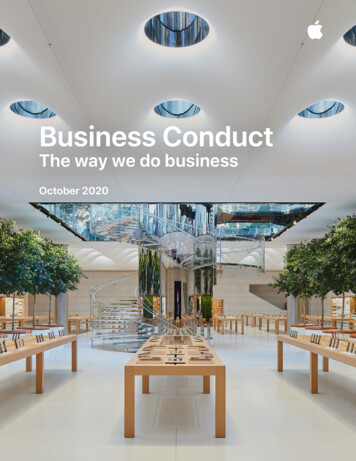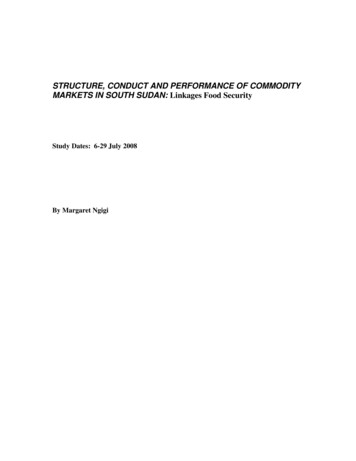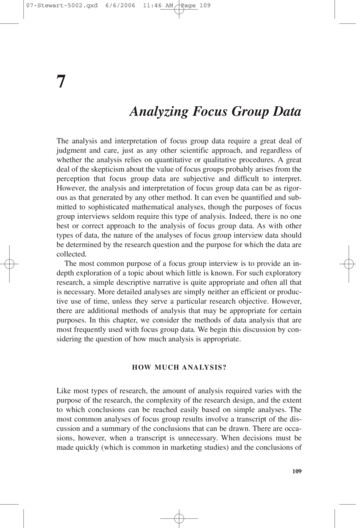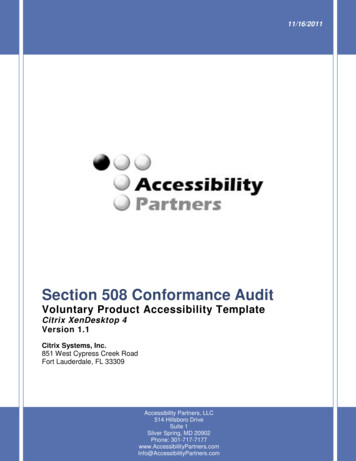
Transcription
Key Area of Activity (KAA-10)‘Society, Culture and Health’Focus group discussion with men in Dares Salaam, Tanzania, about the use ofhealth services during pregnancy anddelivery (photo by C. Pfeiffer).Focus group discussion with elderlyparticipants about ageing, health andcare in Tahuna (North Sulawesi),Indonesia. Wall posters state the FGDtopic, objectives and questions (photo byP. van Eeuwijk).How to Conduct a Focus GroupDiscussion (FGD)Methodological ManualBy Peter van Eeuwijk and Zuzanna Angehrn
What is an FGD?A Focus Group Discussion (FGD) is a qualitative research method and datacollection technique in which a selected group of people discusses a given topic orissue in-depth, facilitated by a professional, external moderator. This method servesto solicit participants’ attitudes and perceptions, knowledge and experiences, andpractices, shared in the course of interaction with different people (see Table 1). Thetechnique is based upon the assumption that the group processes activated duringan FGD help to identify and clarify shared knowledge among groups andcommunities, which would otherwise be difficult to obtain with a series of individualinterviews. Yet, this method does not presume that A) all the knowledge is sharedequally among a studied group, or that B) in each community there is a common,underlying, homogeneous knowledge. Rather, an FDG allows the investigator tosolicit both the participants’ shared narrative as well as their differences in terms ofexperiences, opinions and worldviews during such ‘open’ discussion rounds.Focus Group Discussion(FGD)Individual QualitativeInterviewRegular MeetingParticipantsMultiple participants whoshare one (some)common characteristic(s)that is (are) meaningfulfrom the researchperspective.One individualinterviewee whorepresents a verypersonal and distinctcharacteristic ofimportance from theresearch perspective.Multiple participants whogather at the same placeand have certainknowledge of the studysubject.Mode ofConductSemi-structured; carefullyplanned and cautiouslyexecuted.Ranging from semistructured tounstructured; wellplanned and executed.Unstructured, withoutclear roles assigned toparticipants; no clear-cutscenario.Scope ofInsightsOften a large spectrum ofopinions, notions and/orexperiences; added focuson social interactionbetween participants.Small spectrum ofopinions, notions and/orexperiences but providesdeep individual insights.Often a large butscattered spectrum ofopinions, notions and/orexperiences.Level of FocusHigh level of focus on thegiven topic(s).Level of focus variesdepending on the degreeof structuring.Level of focus largelyuncontrollable.Degree ofParticipationWhen accurately andadequately moderated,all participants contributeequally to the discussion.The whole interview isdedicated to theknowledge, attitudes,opinions and experiencesof one person.Usually, one or a fewparticipants dominateand shape thediscussion.Table 1: Characteristics of different qualitative data collection techniquesSpecific types of FGD groups: ‘Natural groups’: consist of multiple participants who belong to a pre-existinginformal or formal group (e.g. family or kin, co-workers, elderly group, women’sself-help group, neighbourhood club, teachers’ credit association) prior to thestudy. Conducting a focus group discussion with a natural group may revealdiscrepancies and similarities between what people say and how they act, andhow other participants react and comment in response. However, theSwiss TPH - Fact Sheet Society, Culture and Health 1
researcher must be aware that power relations inherent to the group’s socialdynamics (e.g. doctor vs. nurse, parents vs. children, younger vs. olderpersons, men vs. women, better off vs. less well off), might influenceparticipants’ ‘public’ statements. Data analysis must account for this potentialbias. ‘Expert groups’: consist of several people who have particularly good andbroad expert knowledge and experience of the research topic(s). Such groups(e.g. nurses from health district centre, ambulance drivers, or drugstorevendors) tend to be smaller than typical FGDs and are used to solicit largeamounts of highly specific information, although participant statements mayvary.Approaching gender balance in a focusgroup discussion with older women and menand a younger moderator (white shirt on theleft) in Dar es Salaam, Tanzania (photo by J.Gerold).Swiss TPH - Fact Sheet Society, Culture and Health 2
Using FGDs in Health ResearchIn health research, FGDs can be applied to four different phases or stages of ascientific study, each with varying function, role and aim (Khan & Manderson 1992;Barbour 2006, 2014):1. Exploration: At the beginning of an investigation, the researcher may performan FGD to learn more about a given topic or field and to distil importantpreliminary issues regarding his/her study theme.2. Monitoring: An FGD may be performed in the midst of on-going researchactivities to control or supervise the corresponding processes and dynamics(e.g. of a health intervention or a community survey) and to understand thembetter.3. Evaluation: At the end or during the phasing-out stage of a researchprogramme, an FGD with the main target group can be performed to verify,disprove, modify or differentiate the study’s provisional finding.4. Gathering and assessing outcomes: Some time after the completion of aninvestigation or intervention, an FGD may be performed to generate newfindings about potential changes or processes within a target community orgroup and about their effect or impact on the field of health.FGDs are used in studies that aim to understand health-related issues in a particularsocial, cultural, economic, ecological and political context (Barbour 2014). Because itfocuses on group interaction and allows for data to be generated collectively, thismethod performs particularly well in identifying the following topics (among manyothers) (Wong 2008):o How do people name, understand, experience and assess a disease, itssymptoms and causes?o How do people perceive and understand the link between risks, exposuresand disease?o How do they act on it?o How do people distinguish their role in the health system?o What is people’s experience of interaction with health professionals?o Why do people comply with or refuse to adhere to medical treatment orintervention?o What are the specific health needs of particular groups?o What are specific vulnerabilities of people in relation to illness?o Which resources, capabilities and skills can a particular group or individualsdevelop regarding ill health and its treatment and concerning its mitigation andprevention?The FGD technique makes use of the human ability to tell stories and is thereforeparticularly suitable in communities with a low level of literacy and/or a strong oraltradition (Grbich 1999, p.114 foll. Bromley et al. 2003:13). Moreover, it providesbetter access to people who are not outspoken and who would normally fear takingpart in an individual interview, feeling that they have nothing to say or that theycannot address sensitive issues. Still, a researcher must be aware that FGDs tend toelicit opinions, attitudes and experiences that are shared ‘only’ normatively in a groupSwiss TPH - Fact Sheet Society, Culture and Health 3
or community; individual voices that compromise and challenge the group’s positionmight be silenced or go unheard.It is not easy to state whether this technique is appropriate for exploring sensitive,personal or even intimate topics. On one hand, participants might hesitate or beashamed to share very personal experiences or unpopular opinions if the FGD isconducted in a big open group. On the other hand, in a safe, non-threatening andconducive environment, some participants might be encouraged and empowered toovercome stigmas, discrimination or taboos in the presence of other people whohave similar experiences (Kitzinger 1995, 2006).Swiss TPH - Fact Sheet Society, Culture and Health 4
How to Conduct an FGDFormulating the Research Question and Drafting a DiscussionGuideQualitative research is usually an explorative process and therefore flexible, iterative,reflective, non-predictable and contextualized (Silverman 2006). Unlike in quantitativestudies, modifying the research question is possible and even recommended (butnever during an active FGD session!) as is generating new hypotheses and pursuingnew insights if the data suggest doing so. At the same time, a good, general andwell-framed research question is essential to the success of a qualitative study.Focus group discussion with traditional birthattendants in Dar es Salaam, Tanzania(photo by C. Pfeiffer).It is critical to understand the difference between an overall research question and aquestion to be posed during an FGD discussion. The former obviously informs andshapes the latter, but there is no equivalence. A researcher cannot ask participantsto provide an answer to the overall research question. On the contrary, it is his/hertask to formulate appropriate, concrete and articulate questions (often: sub-questionor discussion question) to ask participants, collect their responses, evaluate andcompare them and finally interpret them in a way that makes it possible to answer theoverarching research question (see Figure 1).Swiss TPH - Fact Sheet Society, Culture and Health 5
Main research questionFigure 1: From concrete discussion questions (blue circles) to the principal research questionA short list (between 6 and 12 items) of concrete questions or discussion points iscalled ‘an interview guide’ for an FGD. Items may be derived from abstract models,concepts and theories or from the researcher’s ideas, which are embedded in theoverall research approach. Such workable and operationalizable questions should beopen-ended, free of judgments, inoffensive, comprehensible, justifiable, and notrhetorical.Operational PlanningOperational planning for an FGD includes (Dawson, Manderson, and Tallo 1993): Preparing and developing protocols and informed consent forms. Obtaining official approval of an ethical committee (if required) and/or, in somecontexts, non-official consent from corresponding institution (e.g. fromhospital, school, association) or local community (e.g. through head of village,district officer). Training and instructing assisting staff (e.g. moderator, minute taker, andobserver). Planning time and place of an interview and arranging a venue that allows fora relaxed, safe and comfortable interaction, possibly at a round table. Arranging and testing technical recording equipment (video/audio incl.batteries). Planning recruitment and reimbursement of participants (e.g. for transport,food and/or loss of income – but not in the sense of payment/salary).Sampling and RecruitmentIn qualitative studies, such as in FGDs, sampling is guided by fundamentally differentprinciples than in quantitative surveys. Absolute representativeness is neither anultimate goal nor an outright distinction in qualitative science, and validity of data andSwiss TPH - Fact Sheet Society, Culture and Health 6
results is obtained through different means (e.g. by methodological triangulation,systematic analysis).Participants are typically selected to participate in qualitative research based ontransparent criteria, such as their knowledge, life-experience, particularcharacteristics or role in a group/community (Khan & Manderson 1992). Thisapproach to sampling is called ‘purposive’. Nevertheless, ‘random’ sampling is alsopossible (though not often applied in FGDs), where the researcher assembles abigger group of more or less similar people.The typical size of a focus group discussion is 6 to 12 participants; however, smallergroups are also fine and informative, giving all participants enough time andopportunity to share. A group of only 3 to 4 participants is called a ‘mini group’. Ageneral rule of the thumb is that the more experience and knowledge the participantshave on the given subject, the smaller the group could be.Focus group discussion with village leadersand voluntary village workers in SaravanProvince, Laos, about risks, experiences andrequests regarding trematode diseases.Moderator, minute taker and observer (in theforeground) are state health professionals.Two approaches are used to compose groups: A) sufficient homogeneity to facilitatecomparison between groups, and B) sufficient diversity within groups (Khan &Manderson 1992; Barbour 2005). The first approach seeks to encourage a sense ofwell-being among participants and to reach some consensus on the subject. Thesecond approach proposes that bringing together people with various roles, differingexperiences and diverse backgrounds might yield unexpected, varying and broadranging, yet robust and meaningful results. The researcher has to judge for him/herself which strategy will best serve a particular research topic. Nevertheless,sensitive issues (e.g. sexual and reproductive health, family planning, genderinequality in health, addiction, disability or mental illness) are best discussed inseparated sub-groups. For example, a sub-group exclusive to women and oneexclusive to men, or three to four different sub-groups according to life-cycle stage,or a sub-group for medical professionals and one for non-medical professionals, orcompliant and non-compliant patients, etc. In some cases, FGD participants areasked to share personal data to facilitate the subsequent analysis of their statements.In such circumstances, small, uniform groups that encourage trust and mutualunderstanding are desired.The number of FGDs to hold depends on the type and complexity of the researchtopic. FGDs should generate sufficient data to allow for comparisons and to generateand test theoretical ideas (Barbour 2005). For this purpose, the concept of‘saturation’ can be helpful in many studies. Reaching saturation means reaching apoint where subsequent group discussions no longer provide new insights oroutcomes. Saturation is a clear indication that data collection can come to an endSwiss TPH - Fact Sheet Society, Culture and Health 7
and is only possible when data collection and interpretation take place iteratively(Carlsen and Glenton 2011); that is, when the researcher reviews and thus knowsthe data collected and can assess/evaluate them for completeness and sufficiency.The role of the moderator (left, white shirt) ina focus group discussion is crucial – herewith older women and men in Dar esSalaam, Tanzania (photo by J. Gerold).ConductThe quality of an FGD depends on the experience and skills of the moderator, whoneeds to be capable of “thinking, listening and managing time at the same time”(Lewis 2003). His/her role is to ensure that the discussion topic is clearly introducedand thoroughly addressed, and that the discussion is balanced and inclusive. Despitethis crucial role, the moderator should avoid dominating the group and expressinghis/her own judgments. Instead, he/she should be open, alert, probing andencourage everyone to take part in the discussion. Ideally, the moderator should beable to establish a group dynamic in which participants discuss topics from thediscussion guide among themselves, rather than relying on the moderator to addressand interview participants, one by one (Silverman 2006).A typical FGD proceeds as follows (Dawson, Manderson, and Tallo 1993): Start the discussion with an ‘ice-breaker’, e.g. a round of introduction ofparticipants. Introduce the main topic and the overall research question (e.g. orally, on aposter or as a projected presentation). Ask specific questions listed in the discussion guide (not necessarily in thepre-specified order); a skilled moderator will be able to ensure that allimportant questions (which may be photocopied and distributed to theparticipants) are covered, without interrupting the natural flow of thediscussion. Thank participants and say good-bye.The role of a moderator is very demanding; it is almost impossible for him/her to takedetailed minutes. A video or audio recording of the session is helpful and a standardway of documenting an FGD – but it requires formal agreement from all participants.It is advisable to enlist a minute taker to write down the most important points madeby participants, along with any other ideas or analytical thoughts that come to mindSwiss TPH - Fact Sheet Society, Culture and Health 8
during or right after the discussion. Some FGDs also employ an observer to monitorthe social dynamics between the participants when they discuss particular questions.FGDs may last long, from one to even several hours. It is possible to incorporategroup exercises (e.g. discussing a realistic case or a provocative hypothesis) andprojective techniques (i.e. relatively indefinite and unstructured stimuli are provided tothe participants who are asked to structure them in any way they like, whichunconsciously projects their own desires, expectations, hopes, fears, and/orrepressed wishes) into the course of the discussion, if appropriate for the researchtopic.Focus group discussion with two sub-groupsof older women in Tomohon (North Sulawesi),Indonesia, about body, health and care.Moderator plays an active role in stimulatingdiscussion. Wall poster contains FGDquestions (photo by P. van Eeuwijk).AnalysisA concrete question asked during the discussion is not the same as the overallresearch question. Likewise, what participants say is not equivalent to answering theresearch question. Before answering the research question, a researcher needs toanalyze and interpret the data collected from the FGDs. The analysis of qualitativedata is difficult and very time consuming, therefore be sure to reserve enough timefor this task. Spending time to conceptualize the entire study process before datacollection starts will make it easier to interpret the results later on.Data analysis typically consists of several phases:1. Transcribing recorded statements so that a detailed, written document isavailable about who said what about a particular question. Transcription ofone group discussion takes several hours and generates many pages of text.2. Coding the transcription using ‘codes’ (and corresponding ‘sub-codes’leading to a ‘code path’ or ‘code tree’). Codes are ‘labels’ that summarize orbookmark short fragments of text, and therefore help to sort and structure thedata. Several procedures can be used to established these codes, and it ispossible to include different types of codes in one analysis:a. Deductive codes – those specified before data collection, based on theresearch question; the Framework Method (Gale et al. 2013) is avaluable and frequently used example.b. Inductive codes – those that emerge from the analyzed text itself, as inGrounded Theory (Charmaz 2006).c. Codes referring to the group dynamic, which later help to understandhow a group opinion was established in the course of interaction, e.g.Swiss TPH - Fact Sheet Society, Culture and Health 9
‘opposing’, ‘agreeing’, ‘deferring to the opinion of others’, ‘silencing’ or‘changing mind’ (Barbour 2014).3. Reviewing memos produced by the researcher and other members of theresearch team during the course of the study. Such memos often containreflections on the process of data collection or insights into the researchproblem. The reality is that qualitative data analysis often begins in the field,because a researcher – exposed to data while collecting them – cannot andshould not attempt to refrain from understanding and pre-interpreting data(Pope, Ziebland, and Mays 2000). Such ‘interim analysis’ is one of thestrengths of qualitative research, which allows for refining the researchquestion and instruments when pre-interpreted data suggest the need for it.4. Analyzing and interpreting qualitative data, typically through a two-stepapproach (Silverman 2006; Wong 2008):a. First, look at what people in the group literally said, remembering that thegroup, rather than the individual, is the unit of analysis. This part is rathersimple and descriptive. A researcher performing this initial step of theanalysis will report that, for example, “the consensus achieved by thegroup was ”, “the majority of participants agreed that ”, “there wereseveral contradictory opinions about ”, “almost no one mentioned .”.Please note, however, that quantifying findings, although feasible, doesnot usually add value to scientific research by means of FGDs.b. Second, interpret what people said in an integrated, theoretical way. Thisoften relies on:i. mapping a problemii. identifying patterns, regularities and themesiii. identifying differences and similarities within the data andbetween different sources of dataiv. making comparisons between different groups involved in thetopic (Bromley et al. 2003)5. Establishing validity and reliability through consensus, coherence,triangulation and reflexivity.Conducting a respondent check is a useful first step towards validating theresults. It requires presenting the findings to the discussion participants or tothe community (Bromley et al. 2003:16). It does not require that participantssupport all results and conclusions made by the researcher (and vice versa),but respondent validation can strengthen or weaken the level of trust in theresults, and might bring about new insights and motivate the researcher torefine or modify his/her findings.To successfully establish the reliability of qualitative findings, the researcher isexpected to actively think about how his/her own social, economic, ethnic,religious, cultural, personal and scientific background might influence thechosen scientific approach and mode of interpretation.Finally, contrast qualitative FGD results with findings from other techniquesused in the same or similar study, or with another data source, such asliterature review. This is called ‘triangulation’ or ‘cross-validation’ (for instance,through the application of interview, observation, self-reporting and/or metaanalysis).Swiss TPH - Fact Sheet Society, Culture and Health 10
Software Supporting Qualitative Data AnalysisThere are two types of software that facilitate qualitative analyses- Programs that facilitate transcription, such as Transcriber(http://transag.sourceforge.net/, audio only, freeware) and Transana(http://www.transana.org/, video and audio, to be purchased).- Programs that facilitate coding and interpretation, such as MaxQDA,AtlasTI, QDA Miner (all require purchasing a license).Publication and Dissemination of ResultsThe results of qualitative studies may be published in most health (system) research,public health and epidemiology journals. As in the case of clinical trials andobservational studies, reporting a qualitative study must comply with fixed qualitystandards that enhance rigor and comparability. Two widely used checklists are: COREQ (Consolidated Criteria for Reporting Qualitative Studies) (Tong,Sainsbury, and Craig 2007). RATS (Qualitative Research Review Guidelines) used by Springer andBiomed Central https://old.biomedcentral.com/authors/rats.It is always a good idea to check which reporting standard is preferred by the journalof interest before drafting the manuscript. Better still is to carefully read the reportingguidelines even before the study is conducted. This way a researcher can turnreporting guidelines into a roadmap for research before initiating and ensure that allimportant steps and procedures are followed.Finally, it is good practice and respectful to disseminate the research results amongthe community that assisted and supported the study. Researchers might want towrite a brief and accessible paper summarizing the findings and results, make itavailable to participants and the community and ask for comments, or schedule acommunity dissemination meeting, which may take the form of an FGD.Researchers have to assure confidentiality during the course of disseminatingprovisional findings. This includes securing access to data storage (i.e. at leastpassword-protected), preferably limiting access to only a few researchers for a fixedamount of time (which depends on the overall duration of the research). It isadvisable that the principal investigator/head of project stores one copy of thecollected FGD data in a way that makes it possible to retrieve specific data in thefuture. In general, most safety and confidentiality issues are regulated through anexisting ethical clearance.Swiss TPH - Fact Sheet Society, Culture and Health 11
How to Incorporate an FGD into a Wider StudyFGDs are often part of a bigger research project that also includes other datacollection techniques (quantitative, other qualitative, or mixed methods approaches).FGDs can be combined with, for example, surveys and might then serve as a methodto (Dawson, Manderson, and Tallo 1993): generate sets of pre-specified, valid and comprehensive responses to surveyquestions validate survey questionnaires validate the results obtained from a qualitative surveyAn active and attentive moderator (whiteshirt on the left) facilitates a focus groupdiscussion about health care and agencywith older women and men in Dar esSalaam, Tanzania (photo by J. Gerold).Swiss TPH - Fact Sheet Society, Culture and Health 12
Additional ConsiderationsFGDs with Culturally and Linguistically Diverse CommunitiesConducting research in communities that are culturally different than the researcher’sculture of origin is a challenge. Besides the obvious difficulty in communicating in aforeign language, or via an interpreter, a researcher might also experience afrustration stemming from a poor understanding of norms, values, roles,communication patterns, public practices and power relations in the community fromwhich the FGD participants are recruited (Halcomb et al. 2007). All these factorsmight substantially influence the dynamics of a discussion and subsequently itsresults. Thus, there is a need for cultural sensitivity and social competency in theresearch team, which can be achieved, for example, by engaging members of thelocal study group/community early on. Involving (e.g. in preparing an FGD) bilingualinterpreters, local village health workers or patients, and scientists might greatlyenhance mutual trust and understanding as well as the will for collaboration (Barbour2005). Another good practice is to devote enough time to familiarizing yourself withand adapting to the local culture and the community in situ well before the studybegins.Ethical AspectsAs in any other type of scientific research conducted on people and health, theresearcher has to guarantee to protect the integrity of participants. This meansensuring that participation in the FGD does not bring any physical, mental, emotional,social or economic harm to any of the participants or related third parties (e.g. family,kin, neighbours, friends) – or to the researcher – and that their statements are heldconfidentially (unless specified otherwise) and saved in a secured place. Transcriptscan be published only in fragments and after undergoing a process of strictanonymization (unless consent otherwise granted). The moderator must nevermislead, deceive or misguide participants.Before proceeding with data collection, it is mandatory to obtain informed consentthat is signed by the FGD participants; this requirement is usually part of the studyapproval issued by an ethics advisory board. In general, personal data collectedduring an FGD are subject to relevant and current data protection laws to the sameextent as other personal and biomedical data collected for research.Swiss TPH - Fact Sheet Society, Culture and Health 13
ContactPeter van Eeuwijk: peter.vaneeuwijk@swisstph.chLiteratureBarbour, Rosaline S. 2005. “Making Sense of Focus Groups.” Medical Education39: 742–750.———. 2014. “Analyzing Focus Groups.” In The SAGE Handbook of QualitativeData Analysis, ed. Uwe Flick. London: SAGE Publications, 313–326.Bromley, Helene et al. 2003. Glossary of Qualitative Research Terms. London:King’s College, University of London.Carlsen, Benedicte, and Claire Glenton. 2011. “What about N? A MethodologicalStudy of Sample-Size Reporting in Focus Group Studies.” BMC MedicalResearch Methodology 11(1): 26. z, Kathy. 2006. Constructing Grounded Theory: A Practical Guidethrough Qualitative Research. London, Thousand Oaks, New Delhi: SAGEPublications.Dawson, Susan, Lenore Manderson, and Veronica L. Tallo. 1993. A Manual forthe Use of Focus Groups. Boston: International Nutrition Foundation forDeveloping Countries (INFDC).Gale, Nicola K. et al. 2013. “Using the Framework Method for the Analysis ofQualitative Data in Multi-Disciplinary Health Research.” BMC MedicalResearch Methodology 13(1): 117.Halcomb, Elizabeth J. et al. 2007. “Literature Review: Considerations inUndertaking Focus Group Research with Culturally and Linguistically 2006.01760.x.Khan, Me, and Lenore Manderson. 1992. “Focus Groups in Tropical DiseasesResearch.” Health Policy and Planning 7(1): 56–66.Kitzinger, Jenny. 1995. “Introducing Focus Groups.” British Medical Journal 311:299–302.———. 2006. “Focus Groups.” In Qualitative Research in Health Care, eds.Catherine Pope and Nicholas Mays. Malden, Oxford, Carlton: BlackwellPublishing, 21–30.Lewis, Melinda. 2003. Focus Group Interviews in Qualitative Research: A Reviewof Literature. Sydney. http://www.aral.com.au/arow/rlewis.htmlPope, Catherine, Sue Ziebland, and Nicholas Mays. 2000. “Qualitative Researchin Health Care: Analysing Qualitative Data.” British Medical Journal 320:114–116. 4.Silverman, David. 2006. Interpreting Qualitative Data (3rd Edition). London: SAGEPublications.Swiss TPH - Fact Sheet Society, Culture and Health 14
Tong, Allison, Peter Sainsbury, and Jonathan Craig. 2007. “Consolidated
well-framed research question is essential to the success of a qualitative study. It is critical to understand the difference between an overall research question and a question to be posed during an FGD discussion. The former obviously informs and shapes the latter, but there is no equivalence. A researcher cannot ask participants

